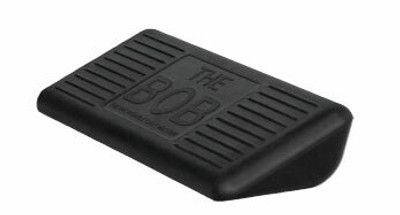 28th Sep 2021
28th Sep 2021
The Versatility and Effectiveness of the BOB – The Incredible Calf Master
For nearly two decades the BOB Incredible Calf Master exercise device has been used in physical and occupational therapy clinics, athletic training rooms, by professional athletes looking to enhance physical performance, and at home by individuals looking to rehabilitate from injury and musculoskeletal conditions as well as to build and stretch their calf muscles. Its reputation has grown and continues to grow as the ultimate device in treating and training the musculoskeletal system of the foot and ankle.
Its unique design provides a versatility that makes the BOB a very effective therapeutic and exercise device in the treatment of plantar fasciitis, ankle sprain rehabilitation, and in the development of larger and more defined calf muscles.
The Unique Design of the BOB
The BOB is formed as a scalene triangle. A scalene triangle is a triangle in which all three sides have different lengths and different degrees as the angles. Its side/end measurements are 6 ¼” W (slope) x 5” W x 3” H, and its face-on side-to-side measurement is 15 3/4 “. These measurements create a scalene type of triangle that can be used to achieve the needed range of motion to stretch both plantar flexor and dorsiflexor muscle groups.
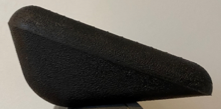 |  |
The “rounded” angles, as compared to pointed angels, also lends to its uniqueness as it allows for rocking movements in both sagittal and frontal planes of motion to challenge and train proprioceptors in the muscles involved in lower extremity balance. Finally, the BOB is made of indestructible urethane for life-long durable wear and performance.
Using the BOB for the Treatment of Plantar Fasciitis
Plantar fasciitis is a condition in which the plantar fascia, a strong connective tissue that extends from the calcaneus (heel bone) to the phalanges (bone segments of the toes) and helps support the arch, becomes inflamed and shortened leading to intense pain felt at the anterior and plantar service of the heel bone.
Click HERE to read our article, “What is the Best Treatment to Quickly Heal Plantar Fasciitis”.
In the treatment of plantar fasciitis, the main interventions for which the BOB is uniquely capable of providing are to:
1. Stretch tight calf muscles (gastrocnemius and soleus): Stretching tight calf muscles ensures proper range of motion and line of muscle pull for proper alignment of the heel. It has been shown that the tightness of the calf muscles forces the rearfoot into a pronated position which places abnormal stress on the plantar fascia leading to irritation and inflammation. Further, a normal range of motion ensures that the proper agonist-antagonist muscle group ratio is achieved eliminating abnormal forces on the joint that can occur when range of motion is restricted.
Read our article, “What is the Main Cause of Plantar Fasciitis”
Using the BOB to stretch tight calf muscles
| 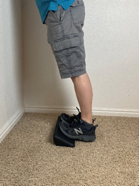 |
| 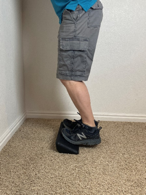 |
Because of the scalene shape, which provides a pivot point, you can rock forward to reduce the degree of stretch, and then move back into the stretch position as when ready for the next rep of hold time in the stretch position.
2. Stretch the plantar fasciitis: The plantar fascia is a connective tissue that has elastin fibers embedded among the collagen fibers that make up the fascia. The collagen fibers provide for tensile strength and support, while the elastin fibers provide a recoil characteristic to help return the plantar fascia to its normal length after being stretched.
When a person sleeps at night the ankles move into a plantar flexed position and the toes to a flexed position. These positions result in the plantar fascia becoming shortened overnight. Similarly, when a person sits and is without weight bearing for an extended period, a similar shortening of the plantar fascia occurs. Then when the person gets out of bed in the morning and stands on the floor, or when a person stands after being seated for a long time, these weight bearing stresses on the plantar fascia cause acute and intense pain.
Using the BOB to stretch the plantar fascia
| 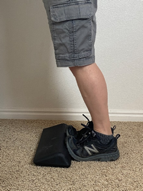 |
3. Strengthen the extrinsic muscles that support the arch. There are three main extrinsic muscles of the ankle/foot that help support the arch with their upward pull applied to the bones on which they insert that are a part of the bony arch configuration. They are the Tibialis Posterior, Tibialis Anterior, and Fibularis (Peroneus) Longus muscles. Strengthening these muscles contributes to the collective support of the arch and reduce stress applied to the plantar fascia.
Using the BOB to strengthen the extrinsic muscles that help support the arch
- With one foot standing length ways on the device, support your body with a hand placed on a nearby wall, and repeatedly move your foot inward (inversion) and outward (eversion). You can also place both feet on the BOB and work both feet/ankles at a time. This causes these three muscles to contract concentrically to overcome the resistive forces and to contract eccentrically to control or decelerate the movements – both serving to strengthen these muscles that contribute to supporting the arch.


Using the BOB for Ankle Sprain Rehabilitation
An ankle sprain is one of the most common occurring athletic injuries. While it happens in virtually all sports, the jumping and landing sports like basketball and volleyball tend to have a high prevalence of occurrence. Approximately 95% of ankle sprains are “inversion sprains” where the foot turns inward causing damage to the lateral ankle stabilizing ligaments. The other approximately 5% of ankle sprains are “eversion sprains” where the foot turns outward causing damage to the medial ankle stabilizing ligaments.
An ankle sprain is associated with specific impairments that if not properly addressed in a progressive rehabilitation program, can dramatically slow the healing process, and may yield some long-lasting deficits. Specifically, 1) the ankle quickly loses range of motion (especially dorsiflexion range of motion as the calf muscles become tight), 2) a loss of proprioceptive sensitivity in the muscles that support and provide reflex contraction protection to the ankle and subtalar joint of the foot, and 3) a loss of muscular strength of all muscles that provide stabilization and support to the ankle and subtalar joints. A failure to address each of these during rehabilitation increases the chance of ankle sprain reinjury, a compensatory injury to other joints, and diminished athletic performance.
1. Stretch tight calf muscles (gastrocnemius and soleus): Because of pain and swelling associated with a sprained ankle, moving the joint through its full range of motion is quickly lost as we try to avoid the extreme ranges exaggerate the pain. If normal range of motion is not maintained or achieved fairly early on in the rehabilitation process, it can slow rehabilitation and delay the individual’s return to sport or normal function.
Using the BOB to stretch tight calf muscles (same as with plantar fasciitis treatment)
- Gastrocnemius: In the standing position with both feet placed on the BOB, lean forward while keeping the knees extended. You should feel a good stretch in the belly of the gastrocnemius muscle near the upper part of the posterior lower leg.
- Soleus: While in the same standing position, bend the knees and lean forward to stretch the soleus muscles, which should be felt near the lower part of the posterior lower leg
NOTE: See photos under “Using the BOB to Treat Plantar Fasciitis #1” above
2. Regain lost proprioceptive sensitivity: Incorporation of balance training will stimulate the muscle spindles of the ankle supporting muscles and help them return to their normal level of responsiveness. This is important for stability purposes, prevention against repeat sprain injury, and in athletic performance.
Using the BOB to regain lost proprioceptive sensitivity
- With one foot standing length ways on the device, support your body with a hand placed on a nearby wall, and repeatedly move your foot inward (inversion) and outward (eversion). This causes ankle invertor and evertor muscle groups to contract concentrically to overcome the resistive forces and to contract eccentrically to control or decelerate the movements – both serving to strengthen these muscles that play a vital role in supporting the ankle against sprain mechanisms.
NOTE: See photos under “Using the BOB to Treat Plantar Fasciitis #3” above
3. Regain muscular strength of all muscles that cross over and support the ankle and subtalar joints and that are integral to athletic performance: When muscles are not worked, they succumb to the effects of a type of immobilization. They atrophy and become weak and therefore cannot perform their functions of athletic performance and protection against injury. Muscles cross the ankle and foot on all sides and are essential to proper gait and athletic performance. Achieving good/normal ratio of agonist-to-antagonist muscle strength of the ankle plantar flexors, dorsiflexors, invertors, and evertors is needed for an athlete to return to sport and function at a high level and with minimal risk of reinjury.
Using the BOB to regain lower leg and ankle muscle strength
- Work the ankle muscles through a full range of motion against resistance – body weight and progress to adding weight to increase the resistive forces that are needed to be overcome. You can begin with both ankles being worked together, and progress to standing on one foot to progressively work the muscles.

Using the BOB for the Development of Larger and More Defined Calf Muscles
The development of large, well-defined, and powerful calf muscles has been an area of discussion or argument for many years. Theories abound as to why the calf muscles are hard to build and develop. These include:
- The calf muscles are constantly used as we walk around every day and therefore the ability for further growth and development is limited as they are already worked with each step we take.
- The gastrocnemius and soleus muscles have a large proportion of slow-twitch oxidative fibers, as compared to fast-twitch glycolytic fibers in comparison to other muscles, that do not respond to heavy training stimulus for growth in size. Also, a person genetics determine the exact number of fast-twitch and slow-twitch fibers we have in our muscles.
- Individuals do not use sufficient weight to train the calf muscles. A perform can perform heel raises to strengthen the calves with a significant amount of weight (heel raises are a second-class lever movement which is built for force), even more than a person can usually squat. However, when have you seen someone perform heel raises with hundreds of pounds of weight.
Regardless of the reason for which the building of large and defined calf muscles may be difficult for some individuals, performing standing (knees extended to focus on the gastrocnemius, and knees flexed to focus on the soleus) heel raises with heavy weights and prioritized and performed consistently overtime seems to be the primary criteria for building large and well-defined calf muscles.

Check out these videos for more information and additional uses of the BOB-The Incredible Calf Master.
You can purchase the bob calf builder by clicking HERE.





